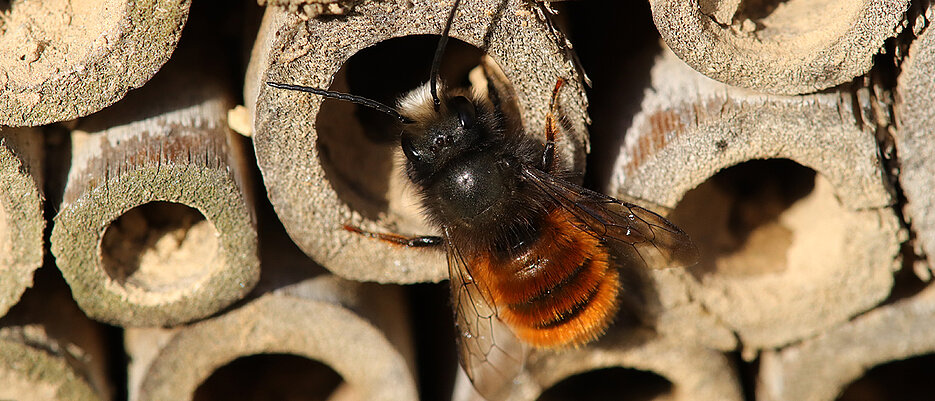Just follow your nose!
07/05/2023How do solitary bees and wasps recognize their homes? Biologists Dr. Sylvie Vandenabeele and Professor Thomas Schmitt investigated this question. They were able to demonstrate the importance of olfactory markers.
Not all bees and wasps live in colonies of several thousand individuals. The horned mason bee (Osmia cornuta), for example, nests solitarily. When choosing a nesting site, the females often use existing cavities ranging from abandoned nests of other bee species to wall cracks and artificial nesting aids such as insect hotels.
Sylvie Vandenabeele has investigated how the bees distinguish their brood cavities from those of their conspecifics as nests are often in close proximity to each other. The biologist now works at the Chair of Zoology II at the Julius-Maximilians-Universität Würzburg (JMU). In the study she worked together with Professor Thomas Schmitt of the Chair of Zoology III, it has now been published in the journal Proceedings of the National Academy of Sciences of the United States of America (PNAS).
Olfactory Markers Point the Way
"Previous studies had suggested that bees use vision to return to their nests. Our hypothesis was that olfactory markers also play an important role," says Sylvie Vandenabeele. Chemical analyses and behavioral experiments showed that bees do use olfactory cues present at their nest entrances. These have the same olfactory profile as the insects bear on their cuticle, the outermost shell.
The importance of the nest olfactory cues became apparent when the researchers removed them: "The bees appeared disoriented, barely able to locate their own nest," explains Vandenabeele.
Better Understanding for Better Protection
The study confirms that the horned mason bee uses multiple senses for orientation, a strategy that is likely to be transferable to different insect species.
Considering the massive decline of pollinators and the resulting impact on our ecosystems, a better understanding of these insects is of the utmost importance. On the one hand, protection and support measures could be optimized. On the other hand, the results of the study open up further possibilities for research in the areas of sensory perception of insects and communication between them.
Sylvie Vandenabeele sees possible next steps for her research in extending the experiments to additional species of solitary nesting Hymenoptera: "For example, there is the question of whether nesting strategies have an influence on the importance of the olfactory component, or even whether predators can also use the scents to locate nests."
Publication
Sylvie Vandenabeele, Thomas Schmitt: Olfaction is essential for nest recognition in solitary Hymenoptera, in Proceedings of the National Academy of Sciences of the United States of America. DOI: 10.1073/pnas.2304703120
Contact
Dr. Sylvie Vandenabeele, Lehrstuhl Zoologie II, Tel: +49 931 31 81920, E-Mail: sylvie.vandenabeele@uni-wuerzburg.de
Prof. Dr. Thomas Schmitt, Lehrstuhl Zoologie III, Tel: +49 931 31 84188, E-Mail: thomas.schmitt@uni-wuerzburg.de
Videos
Video 1: If the olfactory cues are present, the horned mason bee recognizes its nest (marked in purple) immediately and flies into the opening without hesitation. (Video: Sylvie Vandenabeele / Uni Würzburg)
Video 2: After removing the olfactory cues, the bee appears disoriented and obviously cannot distinguish the entrance to the correct nest cavity from visually similar openings. (Video: Sylvie Vandenabeele / Uni Würzburg)










